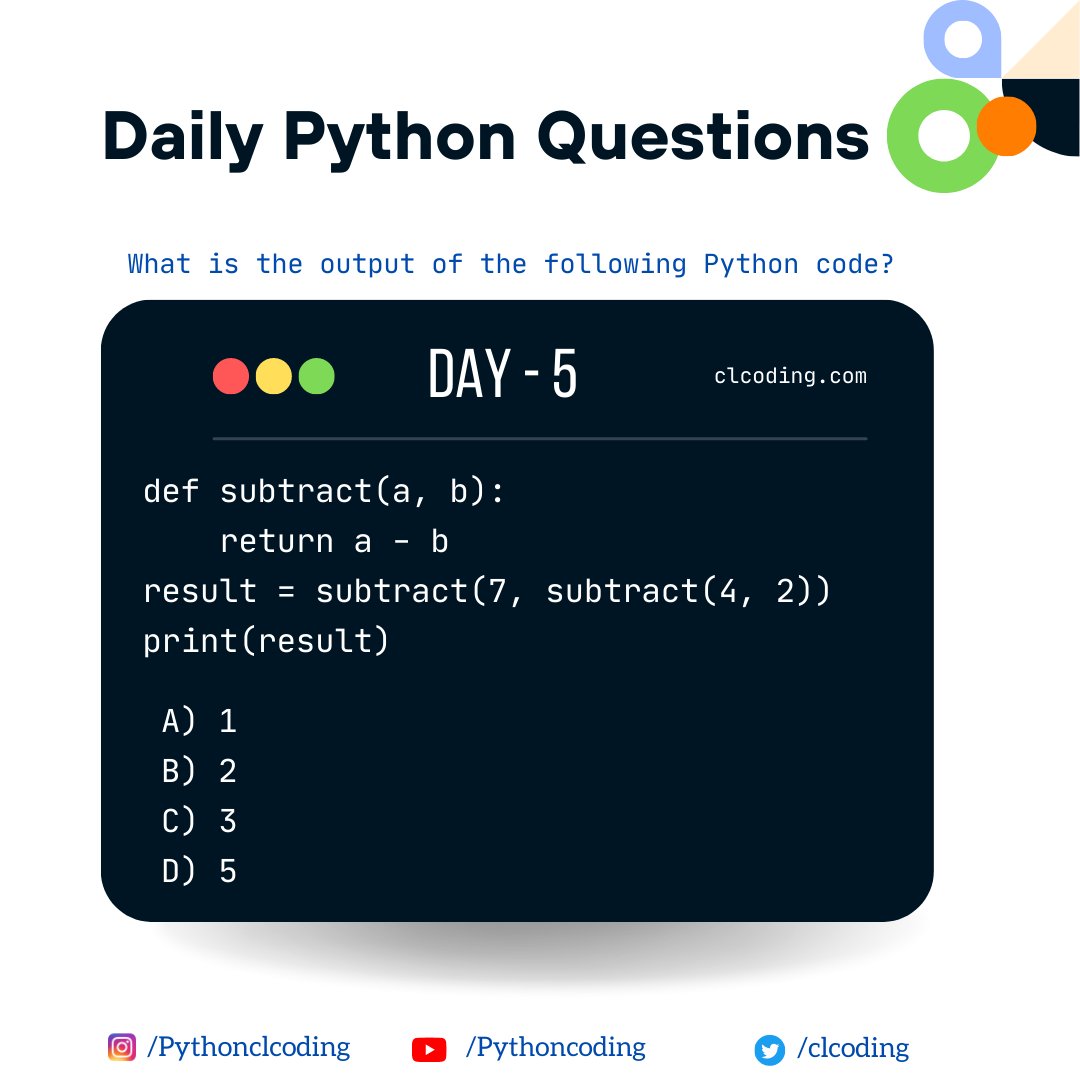Ans is D. 5 Let's dive in ------------- 👉 The script defines a simple function named `subtract` that takes two arguments and returns the result of subtracting the second argument from the first one. 👉 Next, the function `subtract` is invoked twice: once as an argument for the outer call and once as the main function call. ```python result = subtract(7, subtract(4, 2)) ``` To understand the order of evaluation and the ultimate result, let's break down this line step-by-step: 👉 **Function Calls and Evaluation Order** Python evaluates arguments from left to right. However, the inner functions are not necessarily executed before the outer ones due to this left-to-right rule. Instead, the inner function's evaluation occurs because it must be resolved to provide the argument for the outer function. --- 👉 For the code: ```python result = subtract(7, subtract(4, 2)) ``` The inner `subtract(4, 2)` must be evaluated first, so its result can be passed as the second argument to the outer `subtract` function. It's not because of the left-to-right evaluation in this context, but because of the inherent need to resolve the inner function to get its value for the outer function call. 👉 **Nested Call Evaluation** ```python subtract(4, 2) ``` This call subtracts `2` from `4`, yielding a result of `2`. --- 👉 With the result of the nested call determined, the main function call can be rewritten as: ```python result = subtract(7, 2) ``` --- 👉 **Main Call Evaluation** Now, we can evaluate this call. Subtracting `2` from `7`, the result is `5`. --- 👉 Finally, the value `5` is assigned to the variable `result`, and this is the value that gets printed out. ```python print(result) ``` Thus, the script produces the output `5`. --- 👉 **In Conclusion** The function is evaluated inside-out. The inner-most function is computed first and its result is used as an argument for the outer function. This is a common behavior in many programming languages, not just Python, and is grounded in the principle of evaluating expressions from the most nested (or inner) to the least nested (or outer). ------------------ 👉 If you enjoyed this explanation: ✅1. Give me a follow @rohanpaul_ai for more of this every day and ✅2. Like & Retweet this tweet: ✅3. Consider subscribing to my MachineLearning YouTube channel - youtube.com/@RohanPaul-AI #python #100daysofcode #softwareengineer #programming #coding #programmer #developer #coder #code #computerscience #technology #pythonprogramming #software #webdevelopment #webdeveloper #tech #codinglife #algorithms #algorithm #datastructures #programmers #analytics #leetcode #MachineLearning #ArtificialIntelligence #datascience #nlp #100daysofmlcode #nlp #textprocessing #programminglife #hacking #learntocode #softwaredeveloper #interview
@clcoding The function takes two parameters a and b in which it returns the value of their difference. Result variable has two arguments 7 i.e "a" and subtract(4,2) a function to represent "b" So python will execute first the inner function i.e (4-2) and assign it "b".The execute 7-2
@clcoding D. 5 It will execute the first argument, which is 4-2 before it proceeds to execute the second argument
@clcoding Output is 5. In simple mathematical terms: result = (7 - (4-2)) = 7 - 2 result = 5






































